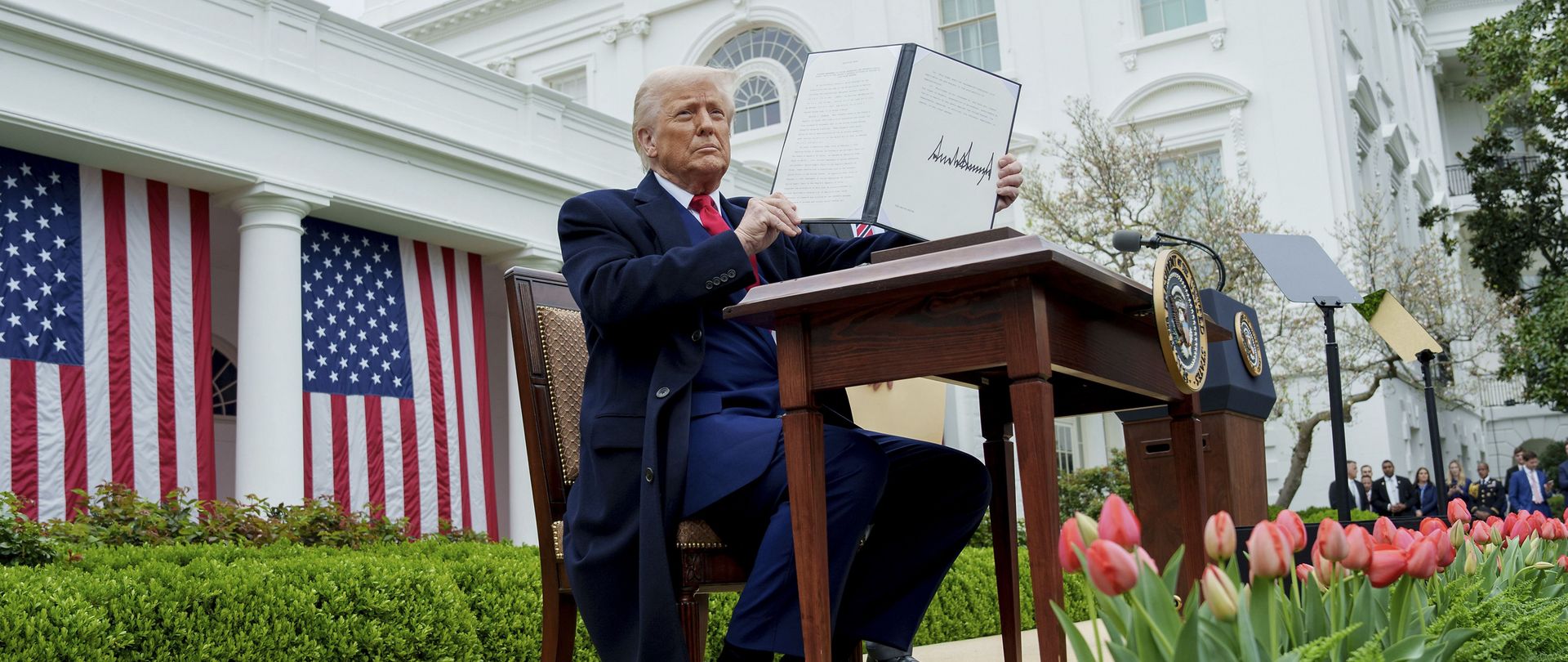
US President Donald Trump holds up the signed executive order for tariffs on almost all imported goods in the Rose Garden of the White House.
© picture alliance / ZUMAPRESS.com | Abe Mcnatt/White House
Economy and Trade
The Trump administration relies heavily on tariffs as an instrument of foreign economic policy. In April 2025, the White House announced a minimum tariff of 10 per cent on all US imports and raised tariffs on 56 countries and the European Union (EU), in some cases to even higher levels. Trump makes no distinction between allies and adversaries, and the EU is severely affected. The exact strategy Trump is pursuing with the tariffs is not entirely clear. The president promises to use tariffs to bring back production and protect domestic industry, while at the same time, seeing tariffs as a source of revenue to finance tax cuts, even if it is unlikely that they will cover the costs of his tax reform. The US president also sees the tariffs as a means of improving his negotiating positions with other countries. Trump wants to change what he perceives as unfair trade relations with US trading partners and force other countries to reduce their trade surpluses with the United States. In doing so, the US president is undermining the rules of the World Trade Organization, whose declining role in resolving international trade disputes is becoming increasingly apparent. The protectionist trade policy, the regressive tax policy, the dismantling of regulations and the administrative state as well as uncertainty about Trump’s additional plans for migration policy appear to be destabilising and shrinking the US economy. There is increased risk of a recession and greater social inequality, which could exacerbate domestic political tensions.
The EU faces difficult negotiations with Trump in the coming years, not least because the US president links his decisions on tariffs to foreign and security policy issues, such as increasing defence spending in NATO. Key divergences on policy are looming regarding China, the regulation of digital companies, and the implementation of climate rules. To force concessions from the EU, Trump may choose to repeatedly employ tariffs and other coercive economic measures.
Publications
-
Trade War and Peace
Three Scenarios and Policy Options Available to the EU and the German Government in Negotiations with President Trump
SWP Comment 2025/C 33, 24.07.2025, 8 Pagesdoi:10.18449/2025C33
-
Economy and National Security
US Foreign Economic Policy under Trump and Biden
SWP Research Paper 2024/RP 11, 28.06.2024, 40 Pagesdoi:10.18449/2024RP11
-
US Presidential Election 2024: Money, trade and the transatlantic economy
What could a second Trump presidency mean for international security and economics? How does the strength of the US-dollar help to maintain America’s global dominance? Laura von Daniels and Mark Copelovitch discuss the challenges of transatlantic relations - regardless of who ends up in the Oval Office.
SWP Podcast 2024/eP 03, 06.06.2024 -
G7 Countries Need to More Deeply Work With the Global South
in: Russia, China, and the G7’s Dilemmas: Global Perspectives on the Summit, Council of Councils, Global Memo, 25.05.2023 (online). -
New US Export Controls: Key Policy Choices for Europe
Recommendations for a robust European export control policy
SWP Comment 2023/C 20, 24.03.2023, 8 Pagesdoi:10.18449/2023C20
-
A Missed Opportunity to Help the World's Poorest Countries
in: Council of Councils, Global Perspectives:Biden's Summitry Was Reassuring for the West. Now Comes the Hard Part, 18.6.2021 (online).